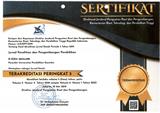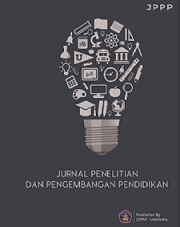Media Dialogis-Interaktif dalam Pembelajaran Online: Praktikalitas dalam Pembelajaran Keterampilan Berbicara
DOI:
https://doi.org/10.23887/jppp.v7i2.59280Keywords:
Media interaktif, Pendekatan dialogis, Keterampilan berbicara, Pembelajaran daringAbstract
Perkembangan teknologi menyebabkan pendidik memiliki banyak alternatif untuk penggunaan media pembelajaran. Salah satunya adalah media interaktif yang dapat digunakan dalam pembelajaran jarak jauh. Namun, penggunaan media interaktif belum efektif digunakan dalam pembelajaran bahasa, khususnya pembelajaran berbicara. Media merupakan aspek penting dalam pembelajaran jarak jauh. Tujuan dari penelitian ini untuk menciptakan media dialogis-interaktif dalam pembelajaran bahasa untuk meningkatkan keterampilan berbicara dalam pembelajaran daring. Jenis penelitian ini adalah Research & Development (R&D) dengan menggunakan model Plomp Development. Teknik pengambilan sampel dengan purposive sampling, diperoleh 30 siswa sebagai uji coba. Metode pengumpulan data menggunakan kuesioner dan lembar dokumen. Instrumen penelitian berupa angket, lembar observasi dan tes. Teknik analisis data yang digunakan dalam penelitian ini adalah teknik analisis data deskriptif. Hasil penelitian menunjukkan nilai kepraktisan diperoleh rata-rata 87,38 dalam kategori sangat baik. Hal ini menunjukkan bahwa media dialogis-interaktif praktis digunakan dalam proses pembelajaran keterampilan berbicara pada pembelajaran daring. Selain itu, media ini praktis untuk meningkatkan aktivitas belajar siswa. Berdasarkan hal itu, media dialogis-interaktif dapat dijadikan sebagai alternatif media dalam pembelajaran bahasa, khususnya pada pembelajaran berbicara.
References
Adarkwah, M. A. (2021). An Outbreak of Online Learning in the COVID-19 Outbreak in Sub-Saharan Africa: Prospects and Challenges. Online Submission, 21(2), 1–10. https://eric.ed.gov/?id=ED612338.
Adedoyin, O. B., & Soykan, E. (2020). Covid-19 pandemic and online learning: the challenges and opportunities. Interactive Learning Environments, 31(2). https://doi.org/10.1080/10494820.2020.1813180. DOI: https://doi.org/10.1080/10494820.2020.1813180
Amoah, S., & Yeboah, J. (2021). The speaking difficulties of Chinese EFL learners and their motivation towards speaking the English language. Journal of Language and Linguistic Studies, 17(1), 56–69. https://doi.org/doi: 10.52462/jlls.4. DOI: https://doi.org/10.52462/jlls.4
Anikina, O. V., & Yakimenko, E. V. (2015). Edutainment as a Modern Technology of Education. Procedia - Social and Behavioral Science, 166, 475–479. https://doi.org/10.1016/j.sbspro.2014.12.558. DOI: https://doi.org/10.1016/j.sbspro.2014.12.558
Anwaruddin, S. M. (2019). Teaching language, promoting social justice: A dialogic approach to using social media. Calico Journal, 36(1), 1–18. https://doi.org/10.1558/cj.35208. DOI: https://doi.org/10.1558/cj.35208
Arifin, Z., Febriani, S. R., & Ansruddin. (2021). Using bloom’s taxonomy in arabic learning media to elevate student’s writing in covid-19 situation. Al-Ta’rib, 9(1), 1–12. https://doi.org/10.23971/altarib.v9i1.2530. DOI: https://doi.org/10.23971/altarib.v9i1.2530
Arroba, J., & Acosta, H. (2021). Authentic digital storytelling as alternative teaching strategy to develop speaking skills in EFL classes. LEARN Journal: Language Education and Acquisition Research Network, 14(1), 317–343. https://eric.ed.gov/?id=EJ1284456.
Asterhan, C. S., Howe, C., Lefstein, A., Matusov, E., & Reznitskaya, A. (2020). Controversies and consensus in research on dialogic teaching and learning. Dialogic Pedagogy, 8, 1–166. https://doi.org/10.5195/dpj.2020.312. DOI: https://doi.org/10.5195/dpj.2020.312
Astuti, L., Wihardi, Y., & Rochintaniawati, D. (2020). The development of web-based learning using interactive media for science learning on levers in human body topic. Journal of Science Learning, 3(2), 89–98. https://doi.org/10.17509/jsl.v3i2.19366. DOI: https://doi.org/10.17509/jsl.v3i2.19366
Atmazaki, A., Ramadhan, S., Indriyani, V., & Nabila, J. (2021). Dialogic-interactive media: Alternative learning media to improve speaking skills. KEMBARA: Jurnal Keilmuan, Bahasa, Sastra Dan Pengajarannya, 7(2), 65–75. https://doi.org/10.22219/kembara.v7i2.16402. DOI: https://doi.org/10.22219/kembara.v7i2.16402
Aukerman, M., & Boyd, M. (2019). Mapping the terrain of dialogic literacy pedagogies. The Routledge International Handbook of Research on Dialogic Education, 373–385. https://doi.org/10.4324/9780429441677-31. DOI: https://doi.org/10.4324/9780429441677-31
Baloran, E. T., Hernan, J. T., & Taoy, J. S. (2021). Course satisfaction and student engagement in online learning anid covid-19 pandemic: A structural equation model. Turkish Online Journal of Distance Education-TOJDE, 22(4), 1–12. https://doi.org/10.17718/tojde.1002721. DOI: https://doi.org/10.17718/tojde.1002721
Baykara, T., & Aksu Ataç, B. (2021). Attitudes of Turkish and foreign students towards English language, and their English speaking anxiety at Turkish international schools in Saudi Arabia. International Online Journal of Education and Teaching (IOJET), 8(1), 485–504.
Bell, T., Urhahne, D., Schanze, S., & Ploetzner, R. (2010). Collaborative inquiry learning: Models, tools, and challenges. International Journal of Science Education, 32(3), 349–377. https://doi.org/10.1080/09500690802582241. DOI: https://doi.org/10.1080/09500690802582241
Carrion, R. G.-, Gomez, A., Molina, S., & Ionescu, V. (2017). Teacher education in schools as learning communities: Transforming high-poverty schools through dialogic learning. Australian Journal of Teacher Education, 42(4), 44–56. https://doi.org/10.14221/ajte.2017v42n4.4. DOI: https://doi.org/10.14221/ajte.2017v42n4.4
Chen, R. J. (2020). Investigating models for preservice teachers’ use of technology to support student-centered learning. Computers & Education, 55(1), 32–42. https://doi.org/10.1016/j.compedu.2009.11.015. DOI: https://doi.org/10.1016/j.compedu.2009.11.015
Ching-Chiang, L. W. C., & Fernández-Cárdenas, J. M. (2020). Analysing dialogue in STEM classrooms in Ecuador: A dual socioeconomic context in a high school. Journal of New Approaches in Educational Research, 9(2), 194–215. https://doi.org/10.7821/naer.2020.7.529. DOI: https://doi.org/10.7821/naer.2020.7.529
Coulter, X., & Herman, L. (2020). The lure of autocratic education in a somewhat democratic society. Athens Journal of Education, 7(4), 331–352. https://doi.org/10.30958/aje.7-4-1. DOI: https://doi.org/10.30958/aje.7-4-1
Delos Reyes, R. J. (2020). Polymedia Based Instruction in Purposive Communication. Puissant, 1(1), 98–113. https://www.ssoar.info/ssoar/handle/document/76835.
Dennis, J. K. (2020). The Kantian Effect: Reconceiving the Integration of Knowledge in Interdisciplinary Theory. JIS Journal of Interdisciplinary Sciences, 4(2), 1–14. www.journalofinterdisciplinarysciences.com.
Dewi, P. A. C., Kristiantari, M. G. R., & Ganing, N. N. (2021). Kontribusi Tindak Pembelajaran Guru Kelas 1 SD pada Peningkatan Keterampilan Berbicara Siswa. Indonesian Journal of Instruction, 2(2), 61–72. https://doi.org/10.23887/iji.v2i2.44511. DOI: https://doi.org/10.23887/iji.v2i2.44511
Dhawan, S. (2020). Online Learning: A Panacea in the Time of COVID-19 Crisis. Journal of Educational Technology Systems, 49(1), 5–22. https://doi.org/10.1177/0047239520934018. DOI: https://doi.org/10.1177/0047239520934018
Dios, M. T. C., & Charlo, J. C. P. (2021). Face-to-Face vs. E-Learning Models in the COVID-19 Era: Survey Research in a Spanish University. Education Science, 11(293), 1–18. https://doi.org/10.3390/educsci11060293. DOI: https://doi.org/10.3390/educsci11060293
Eremeeva, G. R., & Khamisovna, I. F. (2020). Dialogic communication between teachers and students as a condition for interaction of subjects of the higher school educational process. International Journal of Higher Education, 9(8), 46–51. https://doi.org/doi:10.5430/ijhe.v9n8p46. DOI: https://doi.org/10.5430/ijhe.v9n8p46
Febiyanti, D., Wibawa, I. M. C., & Arini, N. W. (2020). Model Pembelajaran Kooperatif Tipe Jigsaw Berbantuan Mind Mapping Berpengaruh terhadap Keterampilan Berbicara. Mimbar Ilmu, 25(2), 282–294. https://doi.org/10.23887/mi.v25i2.26620. DOI: https://doi.org/10.23887/mi.v25i2.26620
Gander, T., & Wintle, P. (2020). Dialogic reflection for social justice - He Anga Huritao. Teachers’ Work, 17(1and2), 38–55. https://doi.org/10.24135/teacherswork.v17i1and2.298. DOI: https://doi.org/10.24135/teacherswork.v17i1and2.298
Gillies, R. M. (2020). Dialogic teaching during cooperative inquiry-based science: A case study of a year 6 classroom. Education Science, 10, 1–20. https://doi.org/10.1016/j.ijer.2015.02.009. DOI: https://doi.org/10.3390/educsci10110328
Goyal, J. K., Daipuria, P., & Jain, S. (2020). An alternative structure of delivering management education in India. Journal of Educational Technology Systems, 1–1. https://doi.org/10.1177/0047239520958612. DOI: https://doi.org/10.1177/0047239520958612
Gül Özenç, E., Orhan-Karsak, H. G., & Özenç, M. (2021). The effects of speaking instruction via whole language approach collaborative instructional design on pre- service teachers’ spe aking anxiety and speaking self-efficacy. International Journal of Curriculum and Instruction, 13(1), 149–168. https://ijci.globets.org/index.php/IJCI/article/view/529.
Halim, L., Abd Rahman, N., Zamri, R., & Mohtar, L. (2018). The roles of parents in cultivating children’s interest towards science learning and careers. Kasetsart Journal of Social Sciences, 39(2), 190–196. https://doi.org/10.1016/j.kjss.2017.05.001. DOI: https://doi.org/10.1016/j.kjss.2017.05.001
Handaru, C. D., & Pujiriyanto. (2020). Analysis of Vocational High School Students Interest on Interactive Learning Multimedia of Product Creative and Entrepreneurship ( PKK ) Subjects Based on Android. International Technology and Education Journal, 4(2), 43–51. https://dergipark.org.tr/en/pub/itej/issue/60167/872427.
Hanif, M. (2020). The development and effectiveness of motion graphic animation videos to improve primary school students’ sciences learning outcomes. International Journal of Instruction, 13(4), 247–266. https://doi.org/10.29333/iji.2020.13416a.
Hanif, Muhammad. (2020). The development and effectiveness of motion graphic animation videos to improve primary school students’ sciences learning outcomes. International Journal of Instruction, 13(4), 247–266. https://doi.org/10.29333/iji.2020.13416a. DOI: https://doi.org/10.29333/iji.2020.13416a
Huizenga, J. C., Dam, G. T. M., Voogt, J. M., & Admiraal, W. F. (2017). Teacher perceptions of the value of game-based learning in secondary education. Computers & Education, 110, 105–115. https://doi.org/10.1016/j.compedu.2017.03.008. DOI: https://doi.org/10.1016/j.compedu.2017.03.008
Inada, T. (2021). Teachers’ strategies for decreasing students’ anxiety levels to improve their communicative skills. English Language Teaching, 14(3), 32–41. https://doi.org/10.5539/elt.v14n3p32. DOI: https://doi.org/10.5539/elt.v14n3p32
Indrayana, B., & Sadikin, A. (2020). Penerapan E-Learning Di Era Revolusi Industri 4.0 Untuk Menekan Penyebaran Covid-19. Indonesian Journal of Sport Science and Coaching, 2(1), 46–55. https://doi.org/10.22437/ijssc.v2i1.9847. DOI: https://doi.org/10.22437/ijssc.v2i1.9847
Jordan, G., & Gray, H. (2019). We need to talk about coursebooks. ELT Journal, 73(4), 438–446. https://doi.org/10.1093/elt/ccz038. DOI: https://doi.org/10.1093/elt/ccz038
Karaya, F., Adıgüzel, M., Üçüncü, G., Çimen, O., & Yilmaz, M. (2021). Teachers’ view towards the effects of covid-19 pandemic in the education process in Turkey. Participatory Educational Research (PER), 8(2), 17–30. https://doi.org/10.17275/per.21.27.8.2. DOI: https://doi.org/10.17275/per.21.27.8.2
Khaleel, F. L., Ashaari, N. S., Wook, T. S. M. T., & Ismail, A. (2016). Gamification elements for learning applications. International Journal of Advanced Science of Engineering and Information Technology, 6(6), 868–874. https://doi.org/10.18517/ijaseit.6.6.1379. DOI: https://doi.org/10.18517/ijaseit.6.6.1379
Komalasari, K., & Saripudin, D. (2017). Value-based interactive multimedia development through integrated practice for the formation of students’ character. TOJET: The Turkish Online Journal of Educational Technology, 16(4), 179–186.
Kumpulainen, K., & Rajala, A. (2017). Dialogic teaching and students’ discursive identity negotiation in the learning of science. Learning and Instruction, 48, 23–31. https://doi.org/10.1016/j.learninstruc.2016.05.002. DOI: https://doi.org/10.1016/j.learninstruc.2016.05.002
Kundu, A., & Bej, T. (2021). Experiencing e-assessment during COVID-19: an analysis of Indian students’ perception. Higher Education Evaluation and Development, 15(2), 114–134. https://doi.org/10.1108/HEED-03-2021-0032. DOI: https://doi.org/10.1108/HEED-03-2021-0032
Lorusso, N. S., & Shumskaya, M. (2020). Online laboratory exercise on computational biology: Phylogenetic analyses and protein modeling based on SARS-CoV-2 data during COVID-19 remote instruction. Biochemistry and Molecular Biology, 48(5), 526–527. https://doi.org/10.1002/bmb.21438. DOI: https://doi.org/10.1002/bmb.21438
Musliadi. (2016). the Problems of Teaching Speaking With Respect To the Teaching Methodology: Task-Based Language Teaching. Ethical Lingua, 3(1), 74–88.
Nadeem, M., Chandra, A., Livirya, A., & Beryozkina, S. (2020). AR-LabOr: Design and assessment of an augmented reality application for lab orientation. Education Science, 10(316), 1–30. https://doi.org/10.3390/educsci10110316. DOI: https://doi.org/10.3390/educsci10110316
Nurtanto, M., Sofyan, H., & Pardjono, P. (2020). E-learning based autoCAD 3D interactive multimedia on vocational education (VE) learning. Journal of Engineering Education Transformations, 34(1), 1–7. https://doi.org/10.16920/jeet/2020/v34i1/147793. DOI: https://doi.org/10.16920/jeet/2020/v34i1/147793
Okay, H. H. (2021). Turkish instrument educators’ distance education experiences related to instrument training during the COVID-19 pandemic. Cypriot Journal of Educational Science, 13(2), 201–222. https://doi.org/10.18844/wjet.v13i2.5690. DOI: https://doi.org/10.18844/wjet.v13i2.5690
Owan, V. J., Ekpe, M. B., & Eneje, S. (2020). Undergraduates’ Utilization of Social Networking Media and Sexual Behaviours in Higher Education: A Case Study. Pedagogical Research, 5(2), 1–8. https://doi.org/10.29333/pr/7940. DOI: https://doi.org/10.29333/pr/7940
Özbek, G., & Uyumaz, G. (2020). The impact of dialogic teaching on academic success and anxiety regarding mathematics courses. In Psycho-Educational Research Reviews | (Vol. 9, Issue 2). https://www.journals.lapub.co.uk/index.php/PERR.
Pan, S. L., & Zhang, S. (2020). From fighting COVID-19 pandemic to tackling sustainable development goals: An opportunity for responsible information systems research. International Journal of Information Management, 55. https://doi.org/10.1016%2Fj.ijinfomgt.2020.102196. DOI: https://doi.org/10.1016/j.ijinfomgt.2020.102196
Pearcy, M. (2020). Do you have your baseball bat?” Dialogic teaching in a remote environment. Research Issues in Contemporary Education, 5(3), 3. https://eric.ed.gov/?id=EJ1293842.
Plomp, T., & Nienke. (2013). Educational design research: An introduction. In T. P. & N. Nieveen (Ed.), Educational design research - Part A: An Introduction (pp. 10–51). SLO.
Putri, P., & Sofyan, H. (2020). A Simulation-Based Interactive Learning Multimedia Development for Photosynthesis and Respiration Practicum in Junior High Schools. Journal of Educational Technology & Online Learning, 3(3), 311–339. https://doi.org/10.31681/jetol.775947. DOI: https://doi.org/10.31681/jetol.775947
Rahayu, P., Ramadhan, S., Siregar, S. D., Jufrizal, Rozimela, Y., Indriyani, V., Zaim, M., & Atmazaki. (2020). Teaching Speaking Through Techno Driven Task ( Zig Zag Task ) Teaching Speaking Through Techno Driven Task ( Zig Zag Task ). IOP Conf. Series: Journal of Physics: Conf. Series 1471 (2020), 1–7. https://doi.org/10.1088/1742-6596/1471/1/012051. DOI: https://doi.org/10.1088/1742-6596/1471/1/012051
Ramadhan, S., Atmazaki, Sukma, E., & Indriyani, V. (2021). Design of task-based digital language teaching materials with environmental education contents for middle school students. Journal of Physics: Conference Series, 1811, 1–8. https://doi.org/10.1088/1742-6596/1811/1/012060. DOI: https://doi.org/10.1088/1742-6596/1811/1/012060
Ramadhan, S., Sukma, E., & Indriyani, V. (2021). Online Distance Learning While the COVID-19 Pandemic: Implementation, Evaluation, and Expectations. Proceedings of the 4th International Conference on Language, Literature, and Education (ICLLE-4 2021), 604, 267–275. https://doi.org/10.2991/assehr.k.211201.040. DOI: https://doi.org/10.2991/assehr.k.211201.040
Rapanta, C., Garcia-Mila, M., Remesal, A., & Gonçalves, C. (2021). The challenge of inclusive dialogic teaching in public secondary school. Comunicar, 29(66), 21–31. https://doi.org/10.3916/C66-2021-02. DOI: https://doi.org/10.3916/C66-2021-02
Resnick, L., Asterhan, C., & Clarke, S. (2015). Socializing intelligence through academic talk and dialogue. AERA. DOI: https://doi.org/10.3102/978-0-935302-43-1
Richardson, J. C., Koehler, A., Besser, E., Caskurlu, S., Lim, J., & Mueller, C. (2015). Conceptualizing and investigating instructor presence in online learning environments. International Review of Research in Open and Distributed Learning, 16(3), 256–297. DOI: https://doi.org/10.19173/irrodl.v16i3.2123
Rohaeti, E. E., Bernard, M., & Primandhika, R. B. (2019). Developing interactive learning media for school level mathematics through open-ended approach aided by Visual Basic application for Excel. Journal on Mathematics Education, 10(1), 59–68. https://doi.org/10.22342/jme.10.1.5391.59-68. DOI: https://doi.org/10.22342/jme.10.1.5391.59-68
Rupenthal, M., & Furuness, S. (2020). A recursive loop in teacher socialization: Extending and improving teacher education curriculum. AILACTE Journal, XVII, 49–66.
Salter, D. J., & Rushe, S. E. (2020). Enhancing learning with oral assessment as a culminating activity for faculty development. Collected Essays on Learning and Teaching, XIII, 112–119. https://doi.org/10.22329/celt.v13i0.6007. DOI: https://doi.org/10.22329/celt.v13i0.6007
Sarıkaya, B. (2020). The effect of speaking education course on the critical speaking skills and speaking anxieties of prospective turkish teachers. International Journal of Field Education, 6(1), 79–91.
Sedova, K., Sedlacek, M., & Svaricek, R. (2019). Teacher professional development as a means of transforming student classroom talk. Teaching and Teacher Education, 57(1), 14–25. https://doi.org/10.1016/j.tate.2016.03.005. DOI: https://doi.org/10.1016/j.tate.2016.03.005
Septiani, A. N. S. I., Rejekiningsih, T., Triyanto, & Rusnaini. (2020). Development of interactive multimedia learning courseware to strengthen students’ character. European Journal of Educational Research, 9(3), 1267–1279. https://doi.org/10.12973/eu-jer.9.3.1267. DOI: https://doi.org/10.12973/eu-jer.9.3.1267
Stewart, T. T., Hill, J., & Lindstrom, P. N. (2020). Exploring wobble through collaborative dialogue to reconcile theory and practice. Teacher Education Quartely, 48–70.
Syafii, M. L., Santoso, S., & Hartono, S. (2021). Story-telling technique utilizing puppets to enhance the learners‟ speaking competence. International Journal on Social and Education Sciences (IJonSES), 3(2), 304–341. https://doi.org/10.46328/ijonses.70. DOI: https://doi.org/10.46328/ijonses.70
Syawaludin, A., Gunarhadi, & Rintayati, P. (2019). Development of augmented realitybased interactive multimedia to improve critical thinking skills in science learning. International Journal of Instruction, 12(4), 331—344. https://doi.org/10.15294/jpii.v8i2.19249. DOI: https://doi.org/10.29333/iji.2019.12421a
Tomak, B. (2021). Evaluation of the “speaking” component of a curriculum applied in a school of foreign languages: An action research in a state university in Turkey. International Journal of Educational Methodology, 7(1), 33–51. https://doi.org/10.12973/ijem.7.1.33. DOI: https://doi.org/10.12973/ijem.7.1.33
Tunagür, M., Kardaş, N., & Kardaş, M. N. (2021). The effect of student centered listening/speaking activities on Turkish listening speaking skills of bilingual students. International Journal of Education & Literary Studies, 9(1), 136–146. https://doi.org/10.7575/aiac.ijels.v.9n.1p.136. DOI: https://doi.org/10.7575/aiac.ijels.v.9n.1p.136
Walsh, A. (2014). SEEK!: creating and crowdfunding a game-based open educational resource to improve information literacy. Insight, 27(1), 63–67. https://doi.org/10.1629/2048-7754.113. DOI: https://doi.org/10.1629/2048-7754.113
Wargadinata, W., Maimunah, I., Febriani, S. R., & Humaira, L. (2020). Mediated arabic language learning for higher education in covid-19 situation. Izdihar: Journal of Arabic Lnguage Teaching, Linguistics, and Literature, 3(1), 59–78. https://doi.org/10.22219/jiz.v3i1.11862. DOI: https://doi.org/10.22219/jiz.v3i1.11862
Winters, T. (2021). Emergency remote studio teaching: Notes from the field. Journal of Teaching and Learning with Technology, 10(special issue), 117–126. https://doi.org/10.29329/ijpe.2021.382.20. DOI: https://doi.org/10.14434/jotlt.v10i1.31580
Wulandari, I. et al. (2021). Indonesian Novice EFL Teachers’ Perceptions of the Use of Peer Assessment in Speaking Class. Journal of English Teaching, 7(1), 67–79. https://doi.org/10.33541/jet.v7i1.2347. DOI: https://doi.org/10.33541/jet.v7i1.2347
Zainuddin, N. (2018). Upaya Meningkatkan Keterampilan Berbicara Bahasa Indonesia Melalui Penerapan Metode Debat Pada Siswa Kelas V SDN 09 Mattekko Kecematan Bara Kota Palopo. Pedagogik Journal of Islamic Elementary School, 1(2), 139–150. https://doi.org/10.24256/pijies.v1i2.401. DOI: https://doi.org/10.24256/pijies.v1i2.401
Downloads
Published
How to Cite
Issue
Section
License
Copyright (c) 2023 Atmazaki Atmazaki, Syahrul Ramadhan, Vivi Indriyani

This work is licensed under a Creative Commons Attribution-ShareAlike 4.0 International License.
Authors who publish with the Jurnal Penelitian dan Pengembangan Pendidikan agree to the following terms:
- Authors retain copyright and grant the journal the right of first publication with the work simultaneously licensed under a Creative Commons Attribution License (CC BY-SA 4.0) that allows others to share the work with an acknowledgment of the work's authorship and initial publication in this journal.
- Authors are able to enter into separate, additional contractual arrangements for the non-exclusive distribution of the journal's published version of the work (e.g., post it to an institutional repository or publish it in a book), with an acknowledgment of its initial publication in this journal.
- Authors are permitted and encouraged to post their work online (e.g., in institutional repositories or on their website) prior to and during the submission process, as it can lead to productive exchanges, as well as earlier and greater citation of published work. (See The Effect of Open Access)







